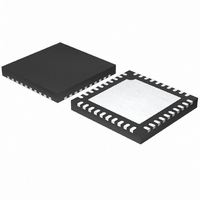MAX1567ETL+ Maxim Integrated Products, MAX1567ETL+ Datasheet - Page 15

MAX1567ETL+
Manufacturer Part Number
MAX1567ETL+
Description
IC DGTL CAM PWR-SUP 6CH 40TQFN
Manufacturer
Maxim Integrated Products
Datasheet
1.MAX1567ETLT.pdf
(35 pages)
Specifications of MAX1567ETL+
Applications
Controller, Digital Camera
Voltage - Input
0.7 ~ 5.5 V
Number Of Outputs
7
Voltage - Output
1.25 ~ 5 V
Operating Temperature
-40°C ~ 85°C
Mounting Type
Surface Mount
Package / Case
40-TQFN Exposed Pad
Lead Free Status / RoHS Status
Lead free / RoHS Compliant
The MAX1566/MAX1567 include the following blocks to
build a multiple-output digital camera power-supply
system. Both devices can accept inputs from a variety
of sources including 1-cell Li+ batteries, 2-cell alkaline
or NiMH batteries, and even systems designed to
accept
MAX1567 include six DC-to-DC converter channels to
generate all required voltages:
• Step-up DC-to-DC converter (_SU pins) with on-chip
• Main DC-to-DC converter (_M pins) with on-chip
• Step-down core DC-to-DC converter with on-chip
• AUX1 DC-to-DC controller for boost and flyback
• AUX2 DC-to-DC controller for boost and flyback
• AUX2 DC-to-DC controller for inverting DC-to-DC
• AUX3 DC-to-DC controller for white LED as well as
The step-up DC-to-DC switching converter typically is
used to generate a 5V output voltage from a 1.5V to
4.5V battery input, but any voltage from V
be set. An internal NFET switch and external synchro-
nous rectifier allow conversion efficiencies as high as
95%. Under moderate to heavy loading, the converter
operates in a low-noise PWM mode with constant
frequency and modulated pulse width. Switching
harmonics generated by fixed-frequency operation are
consistent and easily filtered. Efficiency is enhanced
under light (<75mA typ) loading by an Idle Mode that
switches the step-up only as needed to service the
load. In this mode, the maximum inductor current is
150mA for each pulse.
power FETS
power FETS that can be configured as either a step-
up or step-down DC-to-DC converter
MOSFETs (_SD pins)
converters
converters (MAX1566)
converters (MAX1567)
conventional boost applications; includes open LED
overvoltage protection
both
battery
______________________________________________________________________________________
Step-Up DC-to-DC Converter
Detailed Description
types.
Six-Channel, High-Efficiency, Digital
The
IN
MAX1566/
to 5V can
Camera Power Supplies
The main converter can be configured as a step-up
(Figure 2) or a step-down converter (Figure 1) with the
SUSD pin. The main DC-to-DC converter is typically
used to generate 3.3V, but any voltage from 2.7V to 5V
can be set; however, the main output must not be set
higher than the step-up output (PVSU).
An internal MOSFET switch and synchronous rectifier
allow conversion efficiencies as high as 95%. Under
moderate to heavy loading, the converter operates in a
low-noise PWM mode with constant frequency and
modulated pulse width. Switching harmonics generated
by fixed-frequency operation are consistent and easily
filtered. Efficiency is enhanced under light loading
(<150mA typical for step-up mode, <100mA typical for
step-down mode) by assuming an Idle Mode during
which the converter switches only as needed to service
the load.
Step-down operation can be direct from a Li+ cell if the
minimum input voltage exceeds the desired output by
approximately 200mV. Note that if the main DC-to-DC,
operating as a step-down, operates in dropout, the
overload protection circuit senses an out-of-regulation
condition and turns off all channels.
When generating 3.3V from an Li+ cell, boost-buck
operation may be needed so a regulated output can be
maintained for input voltages above and below 3.3V. In
that case, it may be best to configure the main convert-
er as a step-down (SUSD = GND) and to connect its
input, PVM, to the step-up output (PVSU), set to a volt-
age at or above 4.2V (Figures 1 and 3). The compound
efficiency with this connection is typically up to 90%.
This connection is also suitable for designs that must
operate from both 1-cell Li+ and 2 AA cells.
Note that the step-up output supplies both the step-up
load and the main step-down input current when the
main is powered from the step-up. The main input cur-
rent reduces the available step-up output current for
other loads.
In designs that operate only from 2 AA cells, the main
DC-to-DC can be configured as a boost converter (SUSD
= PVM) to maximize the 3.3V efficiency (Figure 2).
Main DC-to-DC Converter (Step-Up or
Li+ to 3.3V Boost-Buck Operation
2 AA to 3.3V Operation
Step-Down)
15











